This is a Yashica 35 Model M, also known as the Yashica M and Yashica 35M, a 35mm rangefinder camera produced by Yashica starting in June 1960. The Yashica 35 Model M was part of Yashica’s Minister series of 35mm rangefinders, which were loosely based on the body of the earlier Yashica YL but adding an uncoupled selenium light meter. The original Yashica Minister had a slower f/2.8 4.5cm Yashinon lens, but when equipped with the faster f/1.9 lens seen here, the name “Minister” was omitted from the camera’s body and literature. The Yashica 35 Model M is a well built and very capable camera with an excellent lens that was produced during a high point in Yashica’s history.
Film Type: 135 (35mm)
Lens: 4.5cm f/1.9 Yashinon coated 6-elements in 4-groups
Focus: 2.6 feet to Infinity
Viewfinder: Combined Coincident Image Coupled Rangefinder
Shutter: Copal SVL Leaf
Speeds: B, 1 – 1/500 seconds
Exposure Meter: Uncoupled Selenium Cell w/ top plate Light Value Scale
Battery: None
Flash Mount: Cold shoe and M and X Flash Sync
Weight: 784 grams
Manual: https://www.cameramanuals.org/yashica_pdf/yashica_35_m.pdf
How these ratings work |
The Yashica 35 Model M is an early Yashica rangefinder with a basic feature set, uncoupled selenium meter, and a unique rewind handle, but otherwise is like most other 1960s Japanese rangefinders. This one worked well enough, but a dim rangefinder patch made the camera unpleasant to use, and a lens that delivered very soft edges, even stopped down, was a bit of a disappointment. | ||||||
| Images | Handling | Features | Viewfinder | Feel & Beauty | History | Age | |
| 1 | 1 | 1 | 1 | 2 | 0 | 20% | |
| Bonus | none | ||||||
| Final Score | 7.2 | ||||||
History
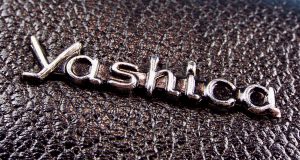 In the early second half of the 20th century, one of the most well known camera brands among amateur photographers was Yashica. The company had a very large lineup of medium format TLRs, 35mm SLRs, and 35mm rangefinders. As the decades passed, and other Japanese companies started to disappear, Yashica continued on with a licensing deal with Zeiss for the Contax name, and was later acquired by Kyocera, a large Japanese ceramics company.
In the early second half of the 20th century, one of the most well known camera brands among amateur photographers was Yashica. The company had a very large lineup of medium format TLRs, 35mm SLRs, and 35mm rangefinders. As the decades passed, and other Japanese companies started to disappear, Yashica continued on with a licensing deal with Zeiss for the Contax name, and was later acquired by Kyocera, a large Japanese ceramics company.
Yashica’s success was not on accident, as the company had the benefit and resources of two different Japanese camera makers which helped them to gain knowledge and market share during the most competitive years of the Japanese camera industry.
Yashica’s history starts in 1940, with several ex employees of Canon who formed the Kōgaku Seiki Company. In 1942, they released their first model, the Nippon, which was a Japanese clone of the popular German Leica camera.
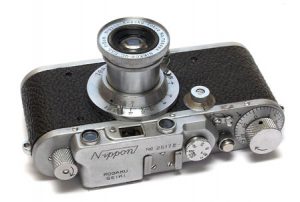
Meanwhile in 1949, the Yashima Seiki Company was founded who primarily made electronic parts for clocks. They eventually moved onto camera parts and released their first camera, the Pigeonflex in 1953 which was based off another German camera, the Rolleicord. In 1948, Kōgaku Seiki Company changed it’s name to Nippon Camera Works, and a year later changed it again to Nicca Camera Works. The company continued to build clones of Leica cameras. Although these early Nicca cameras were not very successful, they remain valuable collector’s items today.
Although both the Yashima and Nicca companies made good cameras, the Japanese camera industry in the 1950s was extremely crowded and confusing with dozens of different companies all popping up producing everything from top of the line interchangeable lens rangefinders to cheap toy cameras. It would take a few years after the war for the rest of the world to have an interest in Japanese copies of German cameras, but throughout the early 1950s, both Yashica and Nicca cameras sold well. A large number of Nicca cameras were sold by the American retailer, Sears, under their house brand Tower.
As the years went on however, the market changed, and a strong preference for the Single Lens Reflex camera, along with more advanced metered models started to eat into the medium format TLR and rangefinder markets.
In 1958, Yashima would acquire Nicca Camera Works. They combined the resources of both companies and changed their name to Yashica Co., Ltd. Yashica would continue to release new TLR models, but would release two previous Nicca models under the Yashica nameplate, called the Yashica YE and YF which used LTM screw mount lenses.
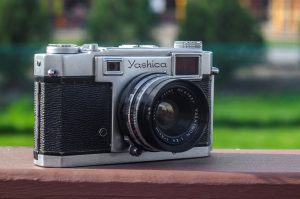
Later that year, Yashica would release it’s first fixed lens rangefinder, the Yashica 35. Although an all new design, this camera had design elements that loosely resembled the Nikon rangefinder of the same era. With the release of the Yashica 35, the company would begin a decade long blitzkrieg of new TLR, SLR, and rangefinder models. Yashica would release several lines of cameras with nearly constant revisions and improvements.
I won’t cover all of the rangefinders here, but starting in 1960, most Yashica rangefinders were split between the Minister and the Lynx series. The Lynx cameras represented the company’s top of the line range, with higher spec lenses, larger bodies and more innovative features. Each year a handful of new models from both lines would be released.
The first Yashica Minister was released in February 1960 and it shared a similar body design to the earlier Yashica YL, but added an uncoupled selenium meter. The Minister was positioned as Yashica’s entry level rangefinder, featuring a modest, but still quite good Yashinon f/2.8 lens and leaf shutter with a top speed of 1/500.

A couple months after the Minister’s release came the more expensive Lynx 1000 which had a faster Yashinon f/1.8 lens and a new shutter with top speed of 1/1000. Strangely, around the same time as the release of the Lynx, came a variant of the Minister called the Yashica 35 Model M. The Model M had a faster Yashica f/1.9 lens which was very similar to the f/1.8 in the Lynx, but retained the Minister’s top speed 1/500 leaf shutter, and added an uncoupled selenium exposure meter.
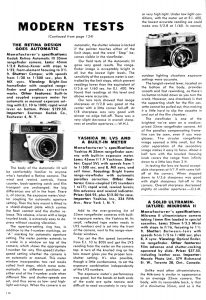
I could not find any ads for the Yashica 35 Model M but in the December 1960 issue of Modern Photography, the camera received a quick test where the editors praised the bright viewfinder and easy rewind lever. Criticisms were that the selenium meter was hard to read near the edges, the rangefinder patch was on the small side, and that the lens lacked sharpness near the edges.
The price of the camera is listed at $64.95 for the camera only, and another $12.50 for the case. When adjusted for inflation, these prices compare to about $590 and $115 today.
By the end of 1960, Yashica’s rangefinder lineup was the f/2.8 1/500 Minister, the f/1.9 1/500 Model M, and the f/1.8 1/1000 Lynx 1000. With only differences in shutters and lenses between the three, this allowed potential Yashica customers the ability to prioritize how they wanted to spend their money, on a faster lens, faster shutter, or both.
The Yashica 35M was not in production long, replaced by an ever growing lineup of Minister and Lynx models including the Lynx 5000, Minister II, and Minister 700.
Today, most collectors are well aware of Yashica’s long range of rangefinders. From the original 35 to the Lynx and eventually the Electro, the company made a great deal of good to excellent cameras. The Yashica 35 Model M was a short lived model that had a great lens on a simple body with an uncoupled meter, likely making it a model not often recommended to beginners. If you don’t expect much in the way of modern conveniences and just want a good lens, it could be an excellent option for you.
My Thoughts
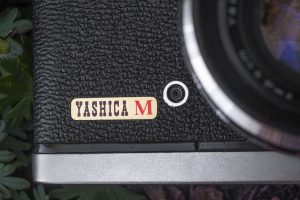
There were many Japanese camera makers who produced both rangefinders and SLRs, but for most of those companies, once the SLR revolution started, the development of new rangefinder models took a back seat. Yashica wasn’t like those companies as for the entirety of the 1960s and a good portion of the 1970s was all-in on both formats, releasing model after model in rapid succession, some with hardly any differences from others.
In the case of the Yashica 35M, this was a camera that was very similar to others the company had at the same time in both features and operation. In my time collecting and using Yashica rangefinders, I can’t honestly say that I have a favorite as they’re all pretty good. This “dilution” of the Yashica brand may have been one of the company’s downfalls however, as I have to imagine that it was pretty hard to keep up to date with all of the new models the company was churning out multiple times each year.
I guess a more simpler way to put what I am trying to say is that for the most part, once you’ve used one Yashica rangefinder, you’ve used them all, and the Yashica 35M does nothing to change that narrative, but that’s also not a bad thing either.
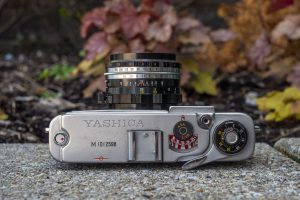
Looking at the top plate, everything is mostly where you’d expect it to be on a Japanese 35mm rangefinder except the rewind knob. In it’s place is a small film transport indicator with a small red dot that spins as film advances through the camera.
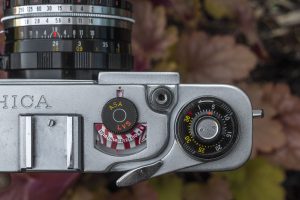
Next to the accessory shoe is the selenium meter’s read out. Like other cameras in the Minister series, the Yashica 35M has an uncoupled meter, which means you set your film speed using the black dial, then while pointing the camera at your subject, you take note at whatever light value it says. In the image to the left, the needle is pointing at the number 13. For proper exposure, you would then select any combination of shutter speeds and f/stops indicated by the number 13 on the black ring with orange numbers on the lens. It’s a pretty easy system to use, but adds an additional level of complexity if the meter doesn’t work, or you just don’t want to use it. Another flaw with a top plate meter readout like this is that you must take your eye away from the viewfinder to take a reading. which not only slows you down, but changes the angle at which the camera is pointed, which could result in an exposure that’s different from when the camera was to your eye,
Continuing on the top plate, we have the cable threaded shutter release, rapid wind film advance lever, and manually resetting exposure counter. The film advance is not geared for multiple short strokes and must be swung all the way before you can fire the shutter, and the exposure counter is additive, showing how many exposures have been made.
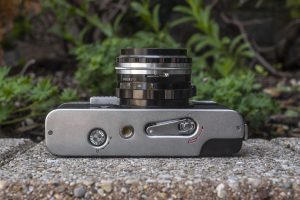
Flipping the camera over, we find the rewind crank which is missing from the top plate. From left to right is the Advance/Rewind switch that also doubles as a pop up for the rewind handle. When the switch is moved to the R position, the tip of the rewind handle is released. The length of the handle allows for a much larger rotation which allows you to rewind the film faster than most cameras. I quite like this implementation and wish that more companies employed a system like this, moving the rewind handle to the bottom of the camera where there’s more room for it. Sadly, even Yashica would stray away from this system on future cameras, making the 35M a “rewinding oddity”. Last, but not least, is the 1/4″ tripod socket for all of your long shutter speed needs.
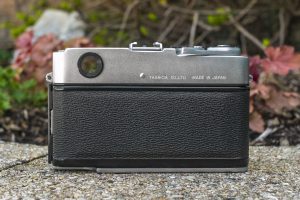
The back of the camera offers little to see other than the large round opening for the viewfinder, an engraving with Yashica’s name and Made in Japan, and finally a large swath of body covering on the door.
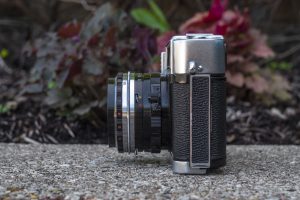
Looking at the camera’s left side, there is the sliding lock for the film compartment and the side of one of the metal strap lugs. From this angle, you can also see a small black handle on the side of the focus ring which is conveniently located within easy reach of your left hand while holding the camera to your eye.
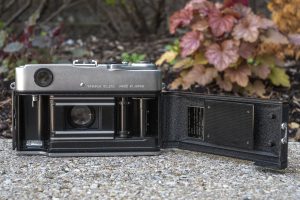
Opening the right hinged film compartment reveals an ordinary looking film compartment. Film transport is from left to right. Without a rewind knob on the top plate to pull up on, the cassette fork cannot be retracted, which necessitates a curved opening near the bottom of the camera allowing you to slide a new cassette in from that side.
The fixed and single slotted take up spool rotates clockwise, meaning film curls opposite of the direction it does in the cassette. The film rails are polished metal and the film pressure plate has a grid of divots to reduce friction on the film as it transports through the camera.
Finally, the Yashica 35M predates the use of foam light seals and on my two examples, both had a felt door seal and yarn film channel seals that did not need replacement.
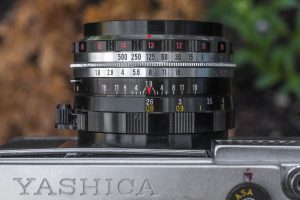
Atop the lens are the usual settings for shutter speed and aperture as you might expect to find on a leaf shutter rangefinder. Regrettably, here is also where you’ll find my least favorite aspect of the Yashica 35M, which if you’ve read my site before you probably know where this is going….
Yes, it’s the LVS or Light Value Scale. Like many metered (and sometimes unmetered) cameras of the 1950s and early 60s, the Yashica 35M has a third scale of numbers from 1 to 17 that correspond to numbers on the selenium meter scale on top of the camera. Now to be fair, when in good working condition, Yashica’s implementation where you take a reading on the meter, and turn the LVS to whatever number it says for perfect exposure actually does work pretty well. I am lucky to have a 35M with a working and accurate meter, so when I forced myself to use the camera as it was intended, the LVS actually worked well.
Problems won’t present themselves until you either try to use a camera with a dead meter, or you want to meter using some other method like Sunny 16, as the coupling between shutter speed and f/stops is difficult to overcome. In the previous image, the camera is set to LV13 with a shutter speed of 1/125 and f/8. Lets say you wanted to select 1/125 and f/2.8. This is easy, just turn the LVS dial from 13 to 10, and the aperture will automatically move to f/2.8 and the shutter speed will remain at 1/125.
But what if you wanted to leave the f/stop at f/8 but change the shutter speed down to 1/30? This requires you to first change the chrome ring so that you move both the shutter speed and f/stops to 1/30 and f/16, then change the LVS ring from 13 to 11 which will keep the shutter speed at 1/30 but move the aperture back to f/8.
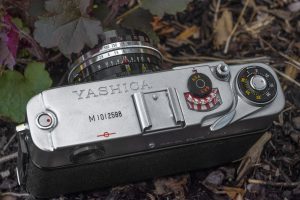
It gets even more confusing if you want to change both the shutter speed and f/stop to something else that doesn’t LVS of 13. This requires a dance of moving one setting, then a second, and sometimes third corresponding setting to get it back to where you want.
But wait, there’s more, the LVS system on the Yashica 35 has physical limits which prevents you from selecting extreme settings like 1/500 and f/1.9 with the LVS still set to 13. In reality, this would require a shutter speed of 1/2000 to use an f/1.9 aperture which the camera doesn’t support, so you must first set the camera to 1/500 and at that extremity, change the LVS to 11 to achieve 1/500 and f/1.9.
If this all sounds confusing, it is. This is not the kind of thing where once you have it in your hands, you’ll get the hang of it, at least not quickly. I imagine that had I been the original owner of this camera, that after time, you’d get used to it, but in the time I had the two Yashica 35Ms I used for this review, I could never get used to it. It wasn’t until I succumbed to the will of the camera and forced myself to use whatever the meter told me, where I could begin to enjoy shooting with it.
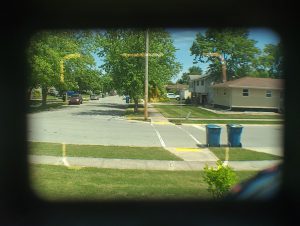
The viewfinder is large and even with a bit of internal haze on this example, showed a good enough contrast to make it easy to use in most situations. The rangefinder patch is round and a bit smaller than I’d like but worked good enough. Lastly, the projected bright lines automatically correct for parallax, which means they travel down and to the right at close focus to adjust for the small distance between the viewfinder window and lens.
The Yashica 35M is a well built and solid feeling camera with a good lens, a large viewfinder, a capable shutter, and a really long rewind lever that makes rewinding film a breeze. As long as you use the uncoupled meter and LVS system as it’s intended, getting proper exposure isn’t that difficult, but with a huge range of alternatives available in 1960 when this camera was sold, I have to imagine quite a few potential customers might have gone with a different model.
That said, like most Yashica cameras of the era, the 35M should make for a competent camera, or does it?
My Results
This Yashica 35 Model M would actually be the third one of these cameras I’ve come across. The first was a parts camera I bought about 5 years ago and was never able to shoot. For this review, I had access to two of them. Both had good shutters, but one had an inoperable rangefinder and stiff focus, but a clear viewfinder. The other had smoother focus, a working rangefinder, but a hazy viewfinder.
For my first roll of film, I took the hazy one with the good rangefinder and loaded in a fresh roll of Fuji 200 and took it out with me as an every day camera, likely how it would have been used when it was new.

The images I got from the Yashica 35M were a mixed bag. I fully expected the 6-element Yashinon lens to perform as well as other Yashinon lenses I’ve shot, but what I ended up seeing were images with quite a bit of softness near the edges and fairly bland rendering. This was fresh Fuji 200 which normally has better colors, so I was surprised at the muted color pallet in these images.
Interestingly, edge sharpness was one of the primary concerns about the camera in the short Modern Tests review I posted earlier in the History section of this article, suggesting that my results were consistent with those from when the camera was new.
The images certainly weren’t bad, in fact, had this had a 3 or 4-element f/2.8 or slower lens, I probably would have complimented these images, it’s just not what I expect from a 6-element sub-f/2 lens from a Japanese company who typically delivers the goods.
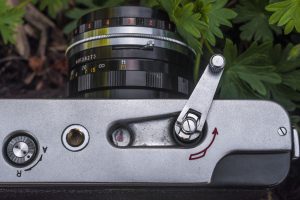
Image quality aside, shooting the Yashica 35M was a rather uneventful experience. There was certainly nothing terrible about it as most Japanese rangefinders from this era have a very similar operation. Mine suffered from poor contrast of the rangefinder, which is typical of 60+ year old cameras, so I won’t fault it for that. For anyone who has never used a camera with an uncoupled meter, it might be a surprise that changes to the shutter speed and aperture have no effect on the meter. Getting used to the coupled LVS takes some time as I struggled with the camera until I succumbed to it’s will, but once I did that, it’s not that bad to use.
I really wanted to love the Yashica 35M. I really enjoyed the Minister D when I shot it a couple of years ago and had hoped that this earlier example with the faster Yashinon lens would be better, but it wasn’t. I did like the longer length of the rewind handle, and the overall look of the camera is pretty, but a dim operation of the viewfinder, poor results from the lens, and nothing else that makes it stand out from several dozen similar cameras means this one is going to sit on a shelf, for a very long time.
Related Posts You Might Enjoy
External Links
http://www.yashicatlr.com/Yashica35.html#minister
https://www.collection-appareils.fr/x/html/camera-11864-Yashica_M.html
https://www.flickr.com/photos/ricardipus/albums/72157633087781639/

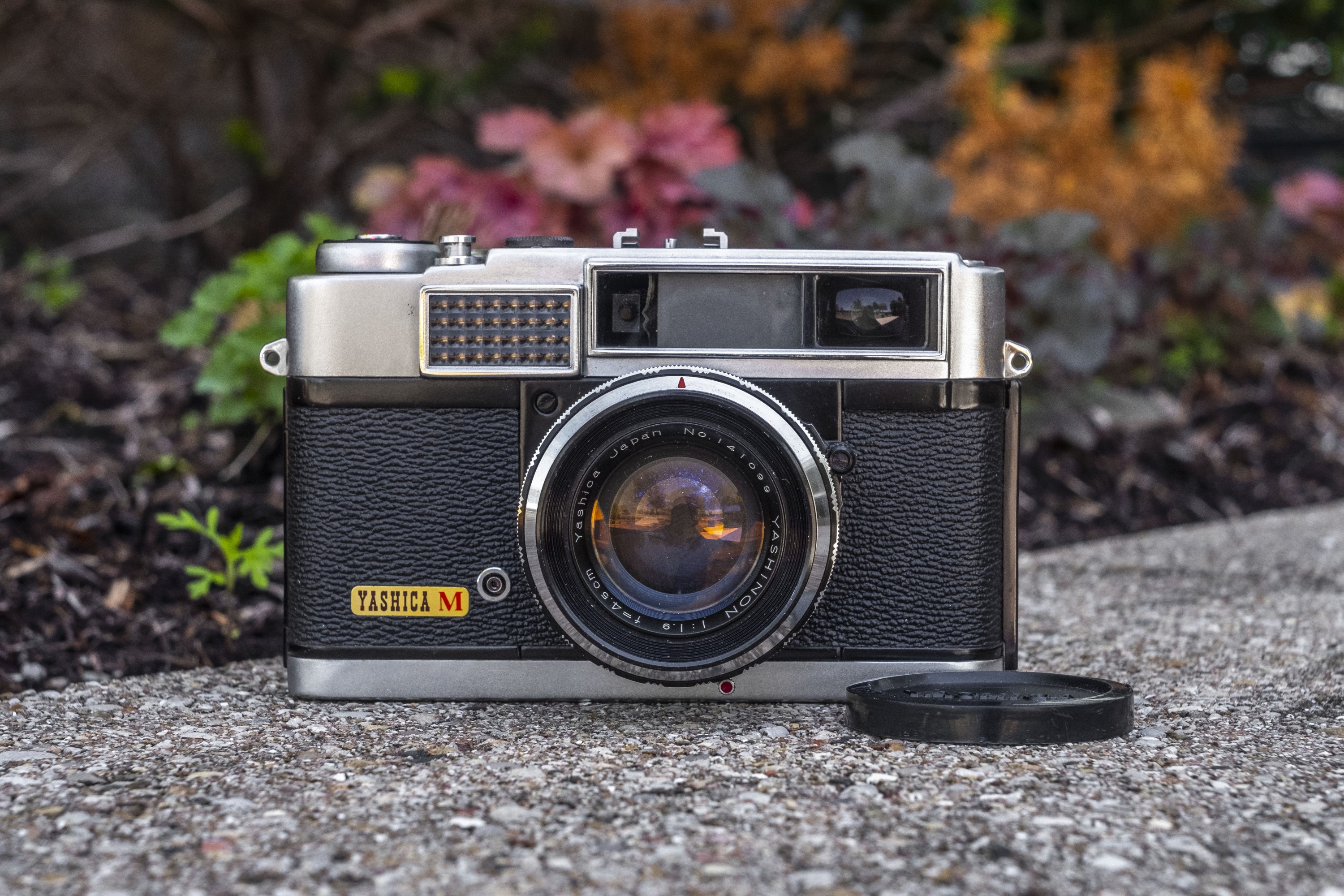
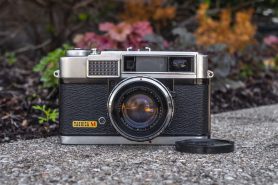
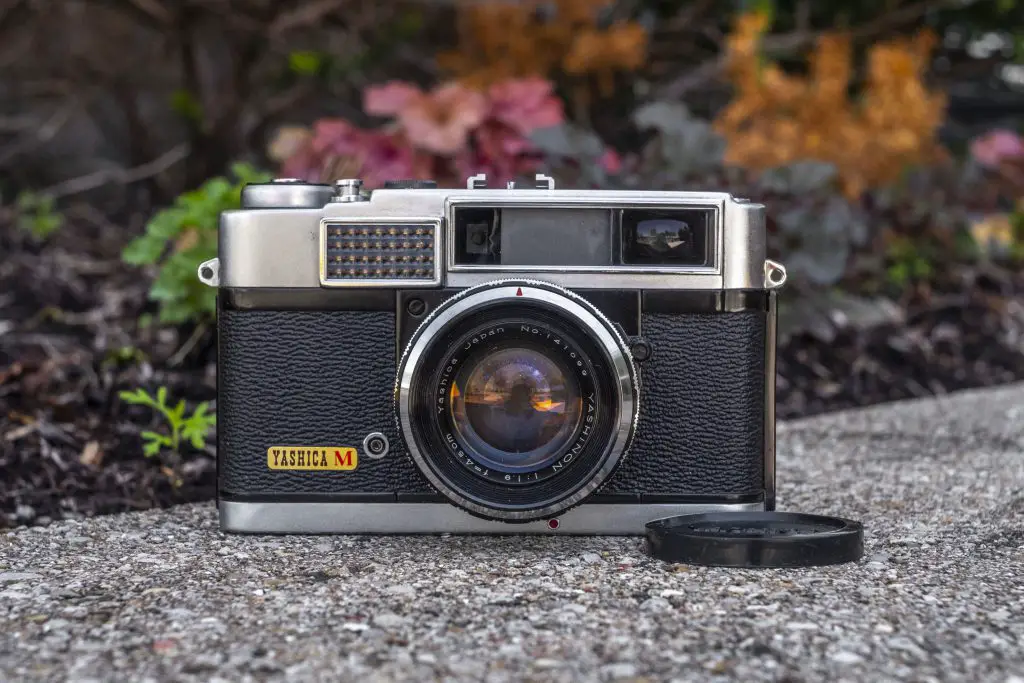












Excellent post as always, Mike. I enjoy the level of detail that goes into its creation. The camera you’ve pictured here (top plate view) has serial number M1012598 which indicates that it was made in January 1961 and was the 2,598th made up to that point in January. My recently acquired M’s SN is M2101662 which puts it in October 1962. That’s a pretty long run IMO during this period in Yashica’s history. My camera simply has Japan on the back just below the cold shoe. It’s the first LVS Yashica that I’ve owned that actually functions. Chris